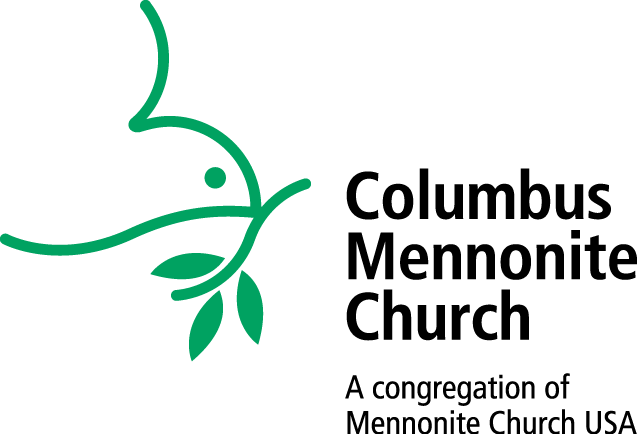Elizabeth and Mary: A holy trimester | December 23 | Advent 4
https://joelssermons.files.wordpress.com/2018/12/20181223Sermon.mp3
Texts: Luke 1:39-56
This sermon was accompanied with a violin playing “My soul cries out,” Sing the Story 124, and vocals singing “Taste and see,” Sing the Journey 86.
Three months ago we were at Camp Luz for fall retreat. After a heavy rain on Friday, it was a lovely weekend to be outside. As usual, we played, ate, sang, talked, and ate some more. Three of us rode our bikes the 100 miles from Westerville to Camp Luz, on the Ohio to Erie trail, rather proud of ourselves and a little surprised for having made it with no major problems. On Sunday Jim Leonard reflected on congregational life. Joe Mas and Linda Mercadante shared thoughts on hiking the Camino in Spain, a lifelong goal fulfilled, a pilgrimage. After the service, we cleaned up and headed home. Pulling out from Ravine Lodge, with my own and another bike strapped to the back of our minivan, I backed directly into a tree. It bent the front wheel of one bike, and the frame of my new road bike. After the somber 100 mile drive home, I took them both to the bike shop. Two days later we celebrated Ila’s sixth birthday.
That was three months ago.
A lot happens in three months. The weather has changed. An election has come and gone. We turn the calendar, people have birthdays and anniversaries. Kids get a little older and taller. Bikes get ridden, bent, fixed, and ridden again. Then suspended in the garage, waiting for warmer days.
Three months was also the length of our summer Sabbatical. I suppose a lot happened then, too, but the best part of a Sabbatical is what doesn’t happen. An extended time away from the normal routine. Time to rest, to restore, time to be intentionally unproductive. On Sabbatical, time is…
Waiting and Watching | December 9 | Advent 2
Texts: Luke 1:68-79; 3:1-6
Speaker: Mark Rupp
The prompt was “Where do I see God in the world around me?” Where do I see God? See God? But what does that even mean?! The more I think about it, the more unsure I become about this whole project of seeing God. Isn’t seeing God reserved for those religious fanatics who insist that their visions are revelations of the Divine that must be heeded at all costs? Aren’t people who see God people that we assume are in need of clinical help of some kind, or at least the kind of people that we can politely ignore? Wouldn’t we expect talk about seeing God to be coming more from street preachers shouting their messages of armageddon doom? Or maybe even from charlatans just looking to make a quick buck from those who are truly desperate for a glimpse of God?
“Where do I see God in the world around me?”
This is the second week on our Advent theme exploring the five senses but our first week focusing in on one of those senses. And “sight” feels like a lot of pressure. It’s probably the one sense that all of us lean on the most heavily. If we can see it, it must be real. There’s a reason the saying is “seeing is believing” and not “smelling is believing.” So it feels like there’s a lot of pressure to get this “sight” week just right because if we can’t talk about “seeing God” coherently, then how are we going to convince anyone that smelling God or tasting God is a worthwhile topic for discussion?
Even the scriptures have a bit of a mixed bag message when it comes to “seeing God.” All the way back in Genesis, we find out that a guy named Jacob decided…
“There will be signs” | December 2 | Advent 1
https://joelssermons.files.wordpress.com/2018/12/20181202sermon.mp3
Texts: Luke 21:25-36; Jeremiah 33:14-16
1963 was the 100 year anniversary of the Emancipation Proclamation. The Civil Rights movement was in full swing. That year King wrote “Letter from a Birmingham Jail.” President Kennedy addressed the nation about why he sent the National Guard to help protect two black students at the University of Alabama. There was the March on Washington with its “I have a dream speech,” the bombing of Sixteenth Street Baptist Church in Birmingham killing four black girls. President Kennedy was assassinated. And, in 1963, African American writer James Baldwin wrote an essay, addressed to his 15 year old nephew, trying to explain why so many white folks were responding to all this with such fear.
To his teenage nephew, coming of age in this world, Baldwin writes this:
“Try to imagine how you would feel, if you woke up one morning to find the sun shivering and all the stars aflame. You would be frightened because it is out of the order of nature. Any upheaval in the universe is terrifying because it so profoundly attacks one’s sense of one’s own reality. Well, the black man has functioned in the white man’s world as a fixed star, as an immovable pillar: and as he moves out of his place, heaven and earth are shaken to their foundations.” — from The Fire Next Time.
I don’t know if James Baldwin had Luke’s gospel open as he wrote, but his words echo those of Jesus.
“There will be signs in the sun, the moon, and the stars, and on the earth distress among nations confused by the roaring of the sea and the waves. People will faint from fear and foreboding of what is coming upon the world, for the powers of the heavens will be shaken.” Luke 21:25-26
Jesus speaks these words…
The thread | November 25
Texts: John 18:33-38a, Revelation 1:4-8
Speaker: Joel Miller
William Stafford was a pacifist and a poet. He died August, 1993. That month, perhaps knowing death was near, he wrote this poem, which he called, “The Way It Is.”
There is a thread you follow. It goes among Things that change. But it doesn’t change. People wonder about what you are pursuing. You have to explain about the thread. But it is hard for others to see. While you hold it you can’t get lost. Tragedies happen; people get hurt or die; and you suffer and get old. Nothing you do can stop time’s unfolding. You don’t ever let go of the thread. —William Stafford
Today is the day in the church calendar known as Christ the King Sunday. Officially, it’s the last Sunday of the liturgical year. Next week begins Advent, when themes of expectation and birth start the cycle all over again. This is the church’s way of keeping time.
As William Stafford observes – over the course of life, “tragedies happen; people get hurt or die. Nothing you do can stop times unfolding.” This past year has been no exception. Yet, there is a thread that goes among things that change.
One of our readings is from the book of Revelation. Appropriately, the last book of our Bible. The author, John, as he calls himself, has been exiled to the island of Patmos. He writes this letter to seven churches across Asia Minor, present day Turkey. It’s a difficult time for these churches. Revelation is a vision, a dream, about the nonviolent Christ, the lamb as it’s envisioned, and the violence of empire, Rome, and all those it enlists to exert its power. Wondrously, it’s the lamb who emerges victorious through the hard slog of history. This is good news for these little churches,…
“Not far from the kin-dom of God” OR Margaret Unchained
https://joelssermons.files.wordpress.com/2018/11/20181104sermon.mp3
Texts: Acts 12:6-11; Mark 12:28-34
Speaker: Joel Miller
If you’re like me, you didn’t grow up observing All Saints or All Souls Day, or even know it was a thing. Either way, each of us have likely accumulated a few saints over the years. These are the people, living and dead, who exemplify a life well lived. We hear their stories and we want to know more. We don’t need them to be perfect, but we need them to show us something. Something of love, something of courage, something of God. Knowing their stories shapes our own. We need these stories = these lives who were, in the words of Jesus, “not far from kin-dom of God.” They help us see that the kin-dom of God can indeed be not far away.
Hebrews chapter 11 walks through a whole ensemble of characters from the Hebrew Bible – From Adam and Eve’s son Abel, to Abraham and Moses, to Rahab, to the prophets. It follows this up by saying, “Therefore, since we are surrounded by so great a cloud of witnesses, let us run with perseverance the race set out for us.”
Observance of All Saints and All Souls, in our own Protestant way, reminds us of that great cloud of witnesses. Even though the question “Who’s in your cloud?” sounds like a tagline for a tech company, it would make for an interesting exercise for each of us to do some cloud mapping and compare clouds. “Who’s in your cloud?”
I like to focus this first Sunday in November on someone from our Anabaptist/Mennonite cloud of witnesses. I’m guessing our Anabaptist-of-the-year this time around is an unknown. I hadn’t heard of her until Paula Snyder Belousek, who pastors Salem Mennonite Church in Elida, Ohio, brought her up at a monthly CDC pastors meeting a…

